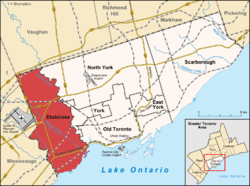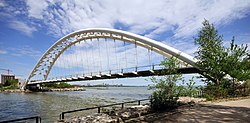
Back Etobicoke CEB Etobicoke German Ετόουμπικοου Greek Etobicoke Spanish اتوبیکو Persian Etobicoke Finnish Etobicoke French אטוביקוק HE Etobicoke Italian エトビコ Japanese
Etobicoke | |
|---|---|
From top, left to right: Humber Bay Park East, Downtown Toronto from Humber Park, Gardiner Expy from Royal York Road, Humber Bay Arch Bridge | |
| Motto: "The Leading Edge of Metro" | |
 Location of Etobicoke (red) compared to the rest of Toronto. | |
| Coordinates: 43°36′58″N 79°30′45″W / 43.61611°N 79.51250°W | |
| Country | Canada |
| Province | Ontario |
| Municipality | Toronto |
| Incorporated | January 1, 1850 (township) January 1, 1967 (borough) June 1983 (city) |
| Changed Region | 1954 Metropolitan Toronto from York County |
| Amalgamated | January 1, 1998 into Toronto |
| Government | |
| • Councillors | Ward councillors |
| • MPs | Federal reps |
| • MPPs | Provincial reps |
| Area | |
| • Total | 123.93 km2 (47.85 sq mi) |
| Population | |
| • Total | 365,143 |
| • Density | 2,946.4/km2 (7,631/sq mi) |
| Demonym | Etobian[1] |
| Time zone | UTC-5 (EST) |
| • Summer (DST) | UTC-4 (EDT) |
| Postal code span | M8V-M9C, M9P-M9R, M9V-M9W |
| Area code(s) | 416, 647, 437 |
Etobicoke (/ɛˈtoʊbɪkoʊ/ ⓘ, e-TOH-bi-koh) is an administrative district and former city within Toronto, Ontario, Canada. Comprising the city's west-end, Etobicoke is bordered on the south by Lake Ontario, on the east by the Humber River, on the west by Etobicoke Creek, the cities of Brampton, and Mississauga, the Toronto Pearson International Airport (a small portion of the airport extends into Etobicoke), and on the north by the city of Vaughan at Steeles Avenue West.
The area of Etobicoke was first settled by Europeans in the 1790s. Primarily an agricultural district, it was incorporated in 1850 as Etobicoke Township. The municipality grew into city status in the 20th century after World War II. Several independent villages and towns developed and became part of Etobicoke, first when Metropolitan Toronto was formed in 1954, and later, in a 1967 consolidation. In 1998, its city status and government dissolved after it was amalgamated into present-day Toronto.
Etobicoke has a highly diversified population, which totalled 365,143 in 2016. It is primarily suburban in development and heavily industrialized, resulting in a lower population density than the other districts of Toronto. Much of its cityscape is characterized by larger main streets, shopping malls, and cul-de-sac housing developments. Etobicoke has several expressways, including Highways 427, 401, 409, the Queen Elizabeth Way (QEW) and Gardiner Expressway. Etobicoke is the western terminus of Line 2 Bloor-Danforth of the Toronto subway and served by four suburban rail stations of GO Transit. Humber College is in Etobicoke, encompassing two campuses, one of which is also home to the University of Guelph-Humber.
- ^ "Etobian sets record straight". The Toronto Star. February 22, 2007. Retrieved August 19, 2015.
© MMXXIII Rich X Search. We shall prevail. All rights reserved. Rich X Search





